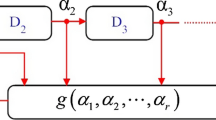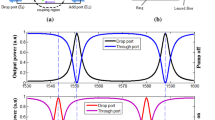Abstract
A scheme for the generation of a pseudo noise (PN) sequence in the optical domain is proposed. The cascaded units of micro-ring resonator (MRR)-based D flip-flop are used to design the device. D flip-flops consist of a single MRR and share the same optical pump signal. Numerical analysis is performed, and simulated results are discussed. The proposed device can be used as a building block for optical computing and for creating an information processing system.

Similar content being viewed by others
References
Haas S M, Shapiro J H. Capacity of wireless optical communications. IEEE Journal on Selected Areas in Communications, 2003, 21 (8): 1346–1357
Maia Borges R, Cerqueira Sodre Junior A. Reconfigurable optical-wireless communications for future generations. IEEE Latin America Transactions, 2015, 13(11): 3580–3584
Chaaban A, Morvan J M, Alouini M S. Free-space optical communications: capacity bounds, approximations, and a new sphere-packing perspective. IEEE Transactions on Communications, 2016, 64(3): 1176–1191
Chen R Y, Yang Z Y. CMOS transimpedance amplifier for gigabit-per-second optical wireless communications. IEEE Transactions on Circuits and Wystems. II: Express Briefs, 2016, 63(5): 418–422
Anguita J A, Djordjevic I B, Neifeld M A, Vasic B V. Shannon capacities and error-correction codes for optical atmospheric turbulent channels. Journal of Optical Networking, 2005, 4(9): 586–601
Niehusmann J, Vörckel A, Bolivar P H, Wahlbrink T, Henschel W, Kurz H. Ultrahigh-quality-factor silicon-on-insulator microring resonator. Optics Letters, 2004, 29(24): 2861–2863
Bogaerts W, De Heyn P, Van Vaerenbergh T, De Vos K, Kumar Selvaraja S, Claes T, Dumon P, Bienstman P, Van Thourhout D, Baets R. Silicon microring resonators. Laser & Photonics Reviews, 2012, 6(1): 47–73
Grover R, Absil P P, Van V, Hryniewicz J V, Little B E, King O, Calhoun L C, Johnson F G, Ho P T. Vertically coupled GaInAsP-InP microring resonators. Optics Letters, 2001, 26(8): 506–508
Ding Y, Ou H, Xu J, Xiong M, An Y, Hu H, Galili M, Riesgo A L, Seoane J, Yvind K, Oxenløwe L K, Zhang X, Huang D, Peucheret C. Linear all-optical signal processing using silicon micro-ring resonators. Frontiers of Optoelectronics, 2016, 9(3): 362–376
Lipson M. Guiding, modulating, and emitting light on silicon-challenges and opportunities. Journal of Lightwave Technology, 2005, 23(12): 4222–4238
Xiao H, Li D, Liu Z, Han X, Chen W, Zhao T, Tian Y, Yang J. Experimental realization of a CMOS-compatible optical directed priority encoder using cascaded micro-ring resonators. Nanophotonics, 2018, 7(4): 727–733
Ishida K. Synchronous pseudo-noise code sequence generation circuit. U.S. Patent 5519736, 1996
Xu Q, Lipson M. All-optical logic based on silicon micro-ring resonators. Optics Express, 2007, 15(3): 924–929
Lee J H, Song I, Park S R, Lee J. Rapid acquisition of PN sequences with a new decision logic. IEEE Transactions on Vehicular Technology, 2004, 53(1): 49–60
Yang L, Guo C, Zhu W, Zhang L, Sun C. Demonstration of a directed optical comparator based on two cascaded microring resonators. IEEE Photonics Technology Letters, 2015, 27(8): 809–812
Zhao Y, Wang X, Gao D, Dong J, Zhang X. On-chip programmable pulse processor employing cascaded MZI-MRR structure. Frontiers of Optoelectronics, 2019, 12(2): 148–156
Little B E, Chu S T, Pan W, Kokubun Y. Microring resonator arrays for VLSI photonics. IEEE Photonics Technology Letters, 2000, 12 (3): 323–325
Condo C, Gross W J. Pseudo-random Gaussian distribution through optimised LFSR permutations. Electronics Letters, 2015, 51(25): 2098–2100
Rabus D G. Realization of optical filters using ring resonators with integrated semiconductor optical amplifiers in GaInAsP/InP. Dissertation for the Doctoral Degree. Berlin: Technische Universität Berlin, 2002
Rakshit J K, Chattopadhyay T, Roy J N. Design of ring resonator based all-optical switch for logic and arithmetic operations-a theoretical study. Optik, 2013, 124(23): 6048–6057
Bharti G K, Rakshit J K. Design and performance analysis of high speed optical binary code converter using micro-ring resonator. Fiber and Integrated Optics, 2018, 37(2): 103–121
Houbavlis T, Zoiros K E, Kanellos G, Tsekrekos C. Performance analysis of ultrafast all-optical Boolean XOR gate using semiconductor optical amplifier-based Mach-Zehnder interferometer. Optics Communications, 2004, 232(1–6): 179–199
Rakshit J K, Roy J N. Silicon micro-ring resonator-based all-optical digital-to-analog converter. Photonic Network Communications, 2017, 34(1): 84–92
Rakshit J K, Roy J N. Design of all-optical universal shift register using nonlinear microring resonators. Journal of Computational Electronics, 2016, 15(4): 1450–1461
Rakshit J K, Roy J N, Chattopadhyay T. A theoretical study of all-optical clocked D flip flop using single micro-ring resonator. Journal of Computational Electronics, 2014, 13(1): 278–286
Asghari M, White I H, Penty R V. Wavelength conversion using semiconductor optical amplifiers. Journal of Lightwave Technology, 1997, 15(7): 1181–1190
Author information
Authors and Affiliations
Corresponding author
Additional information
Rajiv Kumar received his B.Tech degree from RGPV Bhopal, M.Tech degree from BIT Mesra and Ph.D. degree from NIT Jamshedpur, India. His research interest is optical wireless communication.
Ajay Kumar received his B.Tech degree from NIST, Berhampur, M.Tech and Ph.D. degrees from IIT (ISM) Dhanbad, India. His research interest is optical fiber communication and optical logic devices.
Poonam Singh is a professor at NIT Rourkela, India. She received her B.Tech degree from VSSUT, Burla, M.Tech degree from NIT Rourkela and Ph.D. degree from IIT Kharagpur, India. Her research interest is wireless communication. She is a senior member of IEEE.
Niranjan Kumar is a professor at NIT Jamshedpur, India. He received his B.Tech and M.Tech degrees from NIT Jamshedpur, India. He received his Ph.D. degree from IIT Roorkee, India. His research interest is communication and power system.
Rights and permissions
About this article
Cite this article
Kumar, R., Kumar, A., Singh, P. et al. All-optical pseudo noise sequence generator using a micro-ring resonator. Front. Optoelectron. 14, 365–373 (2021). https://doi.org/10.1007/s12200-020-0947-9
Received:
Accepted:
Published:
Issue Date:
DOI: https://doi.org/10.1007/s12200-020-0947-9




